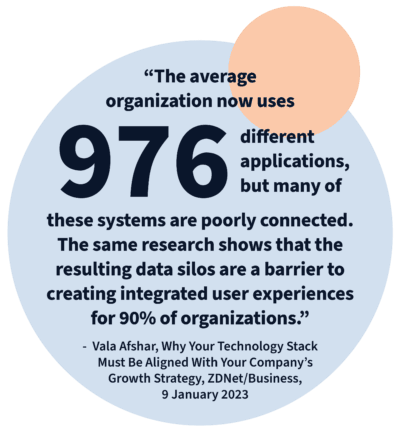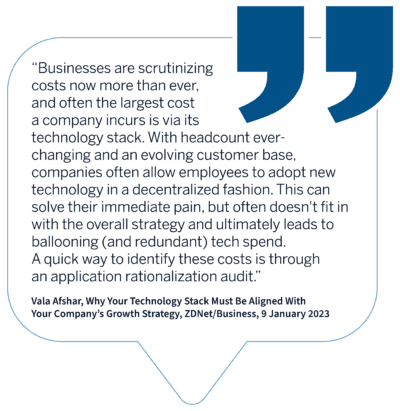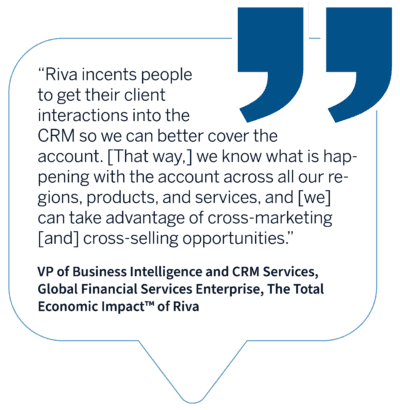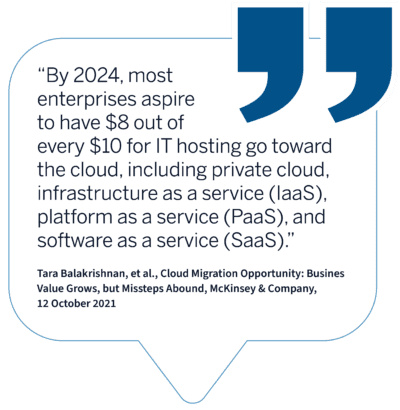
Short-term technology decisions carry long-term consequences
At their heart, most modern enterprises are pragmatic. And while nearly all strive to embrace short- and long-term strategic planning, they often make software purchases to solve immediate problems or address use cases that demand attention. As a result, their decisions, and even their implementations, often overlook data silo and workflow issues those short-term decisions might raise.
While these actions might be shortsighted, they’re understandable—particularly when enterprises assume technologies like CRM will automatically (magically?) bob and weave to accommodate new technologies—and the potentially sticky revenue data integration implications those implementations might raise.
It’s a convenient perfect-world perspective, where CRM solutions like Salesforce and communications platforms like Outlook technologies interact seamlessly, making unified data readily available to the end-users who use it to fuel their interactions, inform their decisions, and drive enterprise revenue growth.
The critical importance of an interconnected tech stack
From a revenue data integration perspective, we don’t live in a perfect world. The data gathered in revenue platforms like CRM simply aren’t automatically unified with data gathered in communications platforms like Outlook—and in new applications implemented to solve short-term challenges. The resulting data silos created by these platforms and applications create gaps that result in incomplete or inaccurate customer intelligence in the system of action.
Meanwhile, today’s enterprise customers have been conditioned to expect a great deal from every engagement. They expect to be remembered; to receive personalized education, guidance, and recommendations; and to enjoy tailored support. As a result, most enterprises recognize the importance of achieving a 360˚ view of the customer.
But while CRM was long promoted as a means to provide comprehensive customer histories, the reality is that they show only part of each customer’s picture. Absent the interaction data gathered via email, calendars, contacts, and more, CRM is just one more data silo in a universe of incomplete data streams customer-facing teams rely on.
More technology isn’t necessarily better

To fill this data gap, enterprises have turned to a range of solutions with varying degrees of success. From manual transcription and CRM-native data integration solutions to single-purpose applications, most of these “solutions” have fallen short, often complicating efforts to unify data and improve its quality. And for those enterprises that turn to single-purpose applications, their proliferation can often work against efforts to solve data issues by creating new burdens for overtaxed IT teams.
As a result, the true solution to enterprise data challenges doesn’t lie in acquiring more technology. It’s more likely to be found through smarter use of existing technology—and the implementation of customer data operations solutions like Riva, designed specifically to unify, govern, and distribute interaction and deal data where and when it’s needed. Unlike manual data transcription and single-purpose applications, proven customer data operations simplify the task of data unification through smart automation—working behind the scenes to boost data quality, bolster data security and compliance, and enhance go-to-market teams’ abilities to meet customer expectations—and drive revenue growth.
Where to start?
Ideally, your enterprise data council has this challenge well in hand. But since you’ve read this far, there’s a good chance your enterprise doesn’t have an established data council. If not, it’s time for you to don your cape and come to the rescue by setting one up. Why? Because the stakes for not having a data council in today’s crowded technology environment are too high.
Without an established process to inventory and assess the role, impact, and value of existing data technology resources—and to evaluate the wisdom of new technology acquisitions, efforts to optimize enterprise technology utility face a steep uphill climb. With an active, organized, and well-supported data council, enterprises can engage inter-departmental collaboration to establish a clear picture of current technology assets, forming a baseline that allows a clear understanding of existing capabilities. The data council can then establish clear guidelines for new technology evaluation processes to democratize the process and clarify decisions for or against requested acquisitions.
Ultimately, the data council will be involved with every subsequent recommendation listed below. But if your enterprise hasn’t established a data council—or if that council is just taking shape—the following ideas provide a roadmap for decisions that can streamline enterprise technology inventories and ensure the optimal use of their capabilities.
8 Essential Steps Toward a Streamlined Revenue Tech Stack

1. Understand what you have
The process of maximizing the value of your existing software begins with a comprehensive data technology inventory. What do you have? What do you use? What do you underuse? What’s new? What’s old? What’s obsolete?
Before you can optimize your assets, you need to understand their capabilities.
2. Assess what you need
Once you’ve taken a cold, hard look at the technology investments you’ve already made, it’s critical to perform an objective review of what your enterprise needs—particularly from the perspective of the sales, marketing, and customer experience teams responsible for ensuring the quality of every customer engagement.
3. Evaluate untapped capabilities of your current revenue technology stack
Most enterprises invest in revenue technologies to achieve very specific objectives. All too frequently, the capabilities of those solutions go well beyond enterprise objectives.
As a result, enterprises often seek new solutions to challenges their current stack might already solve.
4. Integrate systems to leverage existing technologies
Technologies that don’t play together are bad news for enterprise data flows—particularly when their purposes should be aligned. The elephant in the room, of course, is CRM and communications platforms like Outlook.
Think about it: they’re both critical repositories of customer data; they’re both intended as everyday go-to’s for customer-facing teams; and the data gathered in one is more powerful when aligned with the data gathered in the other. But absent a customer data ops solution like Riva to unify, govern, and distribute interaction and relationship data, the potential of CRM and email, calendar, and contact platforms will go unrealized.
Related reading: Guide on Data Connector for Salesforce and Outlook/Exchange
5. Eliminate what you don’t need
Now that you’ve inventoried, assessed, evaluated, and integrated your data tech stack, it’s time to clear out the underperforming, under-used, and obsolete data technology clutter. As business needs change and enterprise teams turn to newer, more promising technologies, old technologies fade into the background—perhaps occasionally turned to by stubborn end-users reluctant to adopt the latest and greatest technologies.
The problem with these semi-retired technologies is that they contribute to enterprise technical debt, either by passively increasing demands on IT teams or by actively complicating other enterprise technology and data flows.
6. Embrace automation—wisely
The importance of automating repeatable tasks and functions grows as AI picks up speed and credibility. Some automation capabilities are built into CRMs and communications platforms—but the unique needs of each enterprise often call for customized automations to effectively and securely govern and distribute customer data. Revenue data operations solutions like Riva are designed to accommodate those customization demands, allowing admins and managers to tailor automations for the specific needs of end-users, teams, and the entire enterprise.
7. Migrate to the cloud
While once viewed with apprehension and skepticism—for reasons ranging from security to control—migration from on-premise to cloud data technology deployment is quickly becoming the accepted standard in nearly every industry. This trend has also accelerated the shift to SaaS applications and platforms.
The rationales are sound: by shifting to a shared responsibility model, enterprises can scale data storage and platform use to suit their needs while alleviating burdens on in-house IT teams. This shift allows those teams to focus on technology initiatives that contribute to growth and revenue objectives.
While cloud deployment doesn’t alleviate the short-term allure of single-purpose applications, it allows enterprises to focus more thoughtfully on evaluating and streamlining the performance of essential, enterprise-wide platforms and less on expanding their technology inventories to meet emergent needs that might be better served through already-integrated platforms.
Related reading: Cloud Migration for Your Customer Data: Is It Finally Time to Make Your Move?
8. Resist the ongoing allure of shiny objects
If you’ve established a data council, it’s important to imbue it with sufficient power to mercilessly evaluate new technology needs/requests and seek solutions that serve the shared needs of departments, teams, and end-users.
Suppose you haven’t established a data council. In that case, it’s essential to foster a management culture committed to making the most of available data tech stack resources—and deliberate in its decisions to embrace new technologies that, while immediately pertinent, may interfere with the integrated operation of current enterprise solutions—or quickly become obsolete.
Conclusion

When it comes to enterprise technology, more isn’t necessarily better. In most situations, more is simply more, as new applications inhibit integration efforts, hinder performance, and elevate security and compliance risks. Occasionally, investment in new technology is essential—as in the case of revenue data operations tools like Riva.
Because these technologies are designed to operate in the background and enhance the performance of primary data technologies, they ultimately reduce the need for single-purpose applications—while reducing the IT and management oversight necessary to make those technologies work.
Recent Articles
- Guide to Einstein Activity Capture: All You Need to Know
- 2024 Bankers Summit: 5 Key Takeaways
- Financial Services: Mastering Customer 360 and Client Engagement for Increased Customer Lifetime Value
- Dreaming Big at Salesforce Education Summit San Diego 2024
- How to Build a Sales Cadence in 2024: Examples and Best Practices

